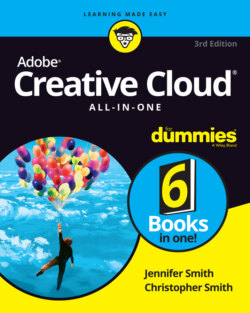Читать книгу Adobe Creative Cloud All-in-One For Dummies - Christopher Smith - Страница 53
Getting to Know the Adobe Bridge Workspace
ОглавлениеBefore you start, locate and launch Adobe Bridge. In the next few steps you will be taken through the steps to install Adobe Bridge, using the Creative Cloud app, and then shown how to launch the application.
If you open your Programs folder (PC) or Application folder (Mac), you will see a folder named Adobe. If you do not see this folder, you will want to review Book 1, “Getting Started with the Creative Cloud Suite,” in order to find out how to download and install your Creative Cloud applications. This folder contains the applications that you downloaded and installed from the Creative Cloud app. If you do not see Adobe Bridge listed, follow these steps:
1 Locate your Creative Cloud application in either your Programs (PC) or Applications (Mac) folder and double-click it to launch it.
2 In the Creative Cloud app, click the All Apps tab, scroll down until you see the Adobe Bridge app, and then click the Install button to the right. Follow the directions provided in order to install the application.
3 After Bridge is installed, you can press the Open button on the right to launch it, or you can find the application in your Programs or Applications folder.
Now that you have launched Adobe Bridge, you might be wondering where to start. In this chapter, we introduce the file management features Adobe Bridge offers in the panels and other menu items shown in Figure 1-1.
Here are some additional details about these components:
Application bar: The Application bar provides buttons for essential tasks, such as navigating the folder hierarchy, switching workspaces, and searching for files. The Application bar is discussed in detail later in this chapter.
Path bar: The Path bar shows the path for the folder you’re viewing and allows you to navigate the directory by clicking on the path locations.
Favorites panel: The Favorites bar provides quick access to frequently browsed folders. Essentially these work the same as shortcuts.
Folders panel: The Folders panel shows the folder hierarchy. You can use it to navigate folders.FIGURE 1-1: The Adobe Bridge workspace.
Filter panel: The Filter panel lets you sort and filter files that appear in the Content panel. You can use this panel to easily find files of the same type, files created on the same date, and more.
Collections panel: The Collections panel offers you the opportunity to use shortcuts to create collections of files that you can easily locate without moving in your directory.
Export panel: The Export panel allows you to drag and drop images to export presets. This is helpful when you are creating batches of images that need to be saved in different sizes and formats.
Content panel: The Content panel displays files specified by the navigational menu buttons, Path bar, Favorites panel, Folders panel, or Collections panel. Basically, these include thumbnails of your files within your selected folder.
Publish panel: The Publish panel lets you upload photos to Adobe Stock from within the Bridge app. This might be used if you are a photographer who wants to submit images to Adobe Stock.
Preview panel: The Preview panel displays a preview of the selected file or files. You can reduce or enlarge the preview by resizing the panel.
Metadata panel: The Metadata panel includes metadata information for the selected file. If multiple files are selected, shared data (such as keywords, date created, and exposure setting) is listed.
Keywords panel: The Keywords panel helps you organize your images by attaching keywords to them.
